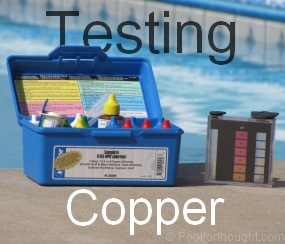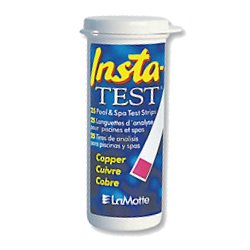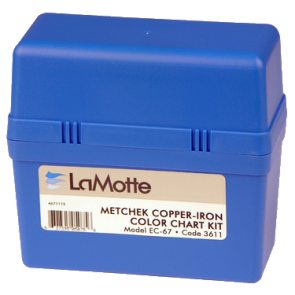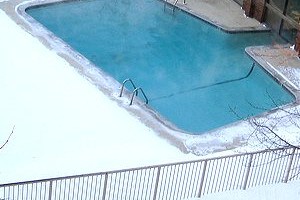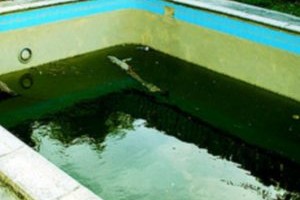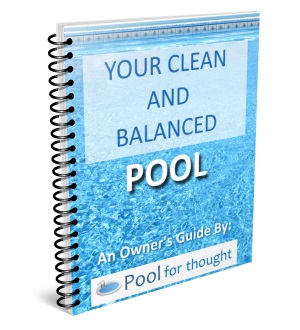In this article, I explain why the copper level in your pool needs to be tested and monitored, ways to test your swimming pool copper level, and a few copper testing tips to make the process easy and painless. I also wrote an article: Pool Water Copper – Causes and Concerns, where I list and explain all the ways copper can enter your pool. After you test the copper level in your pool, read more about how to decrease your swimming pool copper level.
Why is testing pool copper important?
[sc:ad_leaderboard_google]Copper typically increases slowly in pool water over time, because it does not dissipate on its own. So, it is important to keep your water balanced and test copper occasionally, about once per month.
Ideally, you do not want any metals in your pool, including copper. They serve no beneficial purpose, and excessive amounts dissolved in the water can lead to surface staining, which is costly and time consuming to correct. Metals present in the water can also cause problems when testing the pool calcium hardness level, so I recommend lowering your pool copper if you find there is any present in your pool water.
Copper in swimming pool water builds up due to many factors, which I illustrate and explain in this article:
I summarize the main sources of swimming pool copper here:
- Drinking water or tap water usually contains trace amounts of copper, and is usually the same water you use to fill a swimming pool. The small amount of copper present isn’t harmful to drink, but can cause a buildup of copper in pool water over time. As the pool water evaporates, the copper remains in the pool and replacing with fresh water adds a little more copper each time.
- Low pool water pH results in water that is acidic, causing corrosion of copper surfaces. Copper heat exhangers, plumbing, fittings, and metals in some filters are a common source of copper if your pool contains unbalanced water.
- Some algaecides contain copper, especially the kind used to fight black algae. These algecides contain a chelating agent that binds to the copper, preventing it from being dissolved into the pool water. The copper and chelating agent form a chemical structure is absorbed by algae, inhibiting their growth. Over time, chlorine, sunlight, and other factors oxidize this chemical bond, leaving the copper to be absorbed by the pool water and can eventually find its way onto your hair, clothes, and pool walls.
- Some pools use a copper and zinc combination of minerals with a little electrical current, intended to help sanitize the water by a process called ionization and reduce dependence on other sanitizers like chlorine. If the pool water pH is low, copper from an ionizers can erode into the pool water.
- Placing chlorine (Trichlor) tablets in a pool skimmer basket to lower the pool chlorine level can cause trouble. Tablets sitting in the basket can raise the water passing through the basket drastically, lowering the water pH as it goes from the basket to the pool pump, heater, and heat exhangers and corrode metal components, even if the overall pool water pH level is testing fine.
- Less common, but should be mentioned is for pool owners who have pool pump timers, where they risk damage if placing chlorine tablets in the skimmer basket. These tablets can end up sitting in stagnant water as the pump is off for several hours. As the pool pump is restarted, this highly chlorinated charge of water passes through the pool equipment, taking a small amount of copper with it. There is not much damage in a single day, but could build up day after day of repeated on/off cycles.
- Even less common, but possible is copper contamination via excessive water velocity. An over-sized pool pump for the current plumbing can cause high forces on equipment, causing the water to scour and cavitate metal surfaces, slowly eroding small amounts of metal. If all other sources of copper have been eliminated and you still see an ever-present level of copper in your pool, this is an area to investigate.
Eventually the copper builds up until is reaches the saturation point. The water can no longer hold any more copper in-solution, and any remaining amount quickly seeks another chemical to adhere to. The result is metal stains in your swimming pool.
Swimming Pool Copper Test Methods
Testing the copper in your swimming pool is no more difficult than performing most other water tests. There are two primary ways to test copper: test strips and test kits.
Copper Test Strips
Copper level test strips are the easiest way to test. Here are some general instructions or testing your pool with test strips.
- Make sure your pool is open if you have a cover.
- Make sure your hands are clean and dry. Read the package instructions – especially the part on how long to hold the strip in the water.
- Remove a test strip. Dip the strip into the water, about the depth to your elbow, making sure you are in a well-circulated area of the pool
- Move the strip back and forth gently for 5 seconds, then remove it. For heated water samples above 85 degrees, dip strip into water for 1 second and remove immediately.
- Remove the strip and lay it on a flat surface for 60 seconds and out of the sunlight.
- Compare the color on the strip to the color chart included with the test strips.
- You should be able to estimate the copper level based on the color of your strip.
Copper Test Kits
Test kits vary on how they work, but below I describe a common test kit made by LaMotte. The idea behind this test is to compare the resulting color of two tubes.
- Assuming you have test kit, fill the two tubes provided in the test kit to the “full” line.
- Add five drops of the first reagent to the first test tube.
- Gently mix the tube contents together.
- If a yellow-brown color appears, copper is present in the pool water sample. I the water is clear, then you do not need to continue with the remaining steps.
- If you do notice a color change, add one drop of the second reagent to the second tube.
- Look down into the tube, and compare the colors.
- If they are not the same, add another drop and look down. Repeat this process until the colors match in both tubes.
- The test kit will have a chart showing how many drops of the second reagent correspond to how many copper ppm (parts per million) is present in the pool water sample.
- You can use a copper sequestering compound in an amount based on your pool size and the known ppm of copper in your pool to reduce the copper level tested in your pool.
Since copper is a gradually-building issue, a local pool service provider water test may be preferred if you have a service provider that does water sample tests.
Tips on Testing Swimming Pool Copper
[sc:ad_leaderboard_google]If you test your water and you do have copper, then your next step is to lower the pool copper level. If you use a copper/zinc ionizer, or regularly add copper-based algaecide into your pool, then some copper is ok, at around 0.2 ppm.
Conclusion
Testing your water for copper is important, as the buildup of too much copper in your swimming pool water can cause pool surface staining, affect other water tests, plus stain the hair, fingernails, and swimsuits of swimmers. Keeping your water balanced is key step in preventing copper from eroding from expensive pool equipment and into the swimming pool water.
Sources:
- “Pool & Spa Water Chemistry, A Testing and Treatment Guide, Waterproof Edition, 2005. Taylor”
- “Chelation”, Wikipedia
